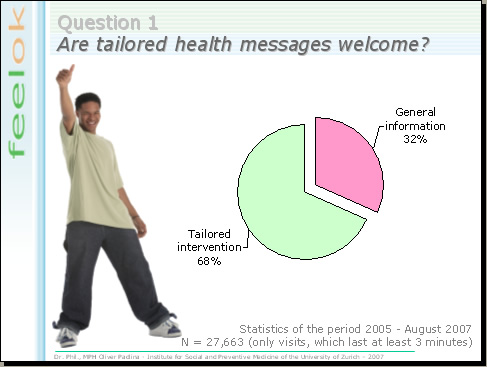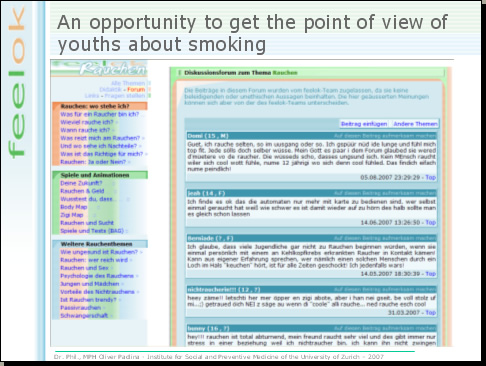|
4th European
Conference Tobacco or Health - Basel, Switzerland - 11 – 13 October, 2007 |
|
|
THE INTERNET-BASED SMOKING PREVENTION PROGRAMME
OF FEELOK – EMPIRICAL EXPERIENCE OF THE LAST 5 YEARS |
|
Padlina Oliver - Jimmy Gerda - Bauer Georg - Gutzwiller Felix |
|
Institute of Social and Preventive Medicine, University of Zurich
|
|
|
| |
|
|
|
The Internet-based intervention "feelok" is 7 years old. It was launched in year 2001 with the goal to address young people at school about health related topics. In 7 years, the program has been visited 1,300,000 times, 9 scientific studies evaluated different aspects of the intervention and we got a large amount of feedback from youths, teachers and experts in public health. With this background information, we have been able to continuously improve the intervention.
|
|
|
|
|
Currently, the feelok website consists of 11 programs about health topics like smoking, cannabis, alcohol, physical activity, nutrition, stress, self-esteem, or sexuality.
15 institutions are responsible for the quality and updating of the content. Our studies show that 60% of the visitors use feelok in the school setting, 75% are youths aged between 12 and 18 years and 60% are girls.
|
|
|
|
|
The smoking prevention program of feelok has been online since 2002 and consists of 8 modules. For the 7 stages of change the program offers a tailored intervention. There is for instance a section for youths who smoke and don't want to stop, another section for those who think it would be good to stop smoking and another one for those who are determined to stop smoking. There are also different tailored interventions for non-smokers. One for those who don't show any interest in starting to smoke, one for those who are curious about trying it out and one for those who are former smokers.
For young people who are only looking for general information about smoking, a general section is available.
|
|
|
|
|
We have conducted several studies about the smoking prevention program resulting in interesting findings.
feelok and other projects in the field of public health offer a tailored intervention based on the assumption that tailored information is more effective than non-tailored information. Several studies which examined this assumption have yielded contradictory results. In contrast, we couldn't find any studies which address the question if tailored health messages are welcome by the target group or not.
Within our research, we investigated this important aspect and found that nearly one third of our visitors were not interested in the tailored intervention and chose only the general section of the smoking prevention program. The other 68% of the visitors decided, on the other hand, to access the tailored information. We would therefore conclude that a relevant segment of our target group refuses tailored information.
|
|
|
|
|
To check the validity of this conclusion we conducted further research. Version 1 of the smoking prevention programme consisted of two sections. One with general information and one with the 7 tailored interventions. Our user statistics for version 1 showed that the intervention was visited nearly 950 times per month. We decided to remove the general section for version 2 in order to verify if the number of visits would decrease. Version 2 of the smoking prevention program offered only a tailored intervention for 7 different stages of change without a general section. Our data showed that the number of visits decreased remarkably to 650 units. We decided to re-integrate the general section for version 2.1 of the smoking prevention program. The number of visits increased considerably and reached nearly 1,000 units per month.
In our opinion there is thus evidence that the majority of the visitors appreciate a tailored intervention, but also that one third prefers to get only general information. For this reason, we suggest that interventions should provide tailored as well as general information.
|
|
|
|
|
A further important question is whether it is possible to reach smokers who don't want to stop smoking with tailored information, this means the pre-contemplator in the transtheoretical model. Our findings show that 32% of those who chose the tailored intervention were convinced non-smokers. We also see that the second biggest group are those who don't want to stop smoking, 19% are in this stage. Based on these data, we conclude, that it is possible to reach smokers who don't want to stop smoking with tailored information, if the dissemination strategies are adequate. In the case of feelok, dissemination primarily takes place at school. This could explain why we are able to reach such a high number of pre-contemplators with this intervention.
|
|
|
|
|
The visitors, who chose the general section of the smoking prevention program spent 23 minutes on average working with it. The visitors who chose one of the 7 tailored interventions stayed with it for 14 to 21 minutes on average. These findings support our impression, that the visitors of the feelok program appreciate this intervention.
|
|
|
|
|
The feelok forums give youths the opportunity to report their problems, considerations and thoughts in relation to smoking. These contributions are public and can be viewed by anyone. This means: the smoking prevention program offers experts an insight into the values and considerations of the young visitors. Experts, who want to better understand what young people think and feel about smoking, can obtain useful detailed information through this tool of feelok.
|
|
|
|
|
For more information please don't hesitate to contact us. The email address is info@feelok.ch. For German speaking people the website offers a lot of information about the project, the intervention and our research's activities.
|









